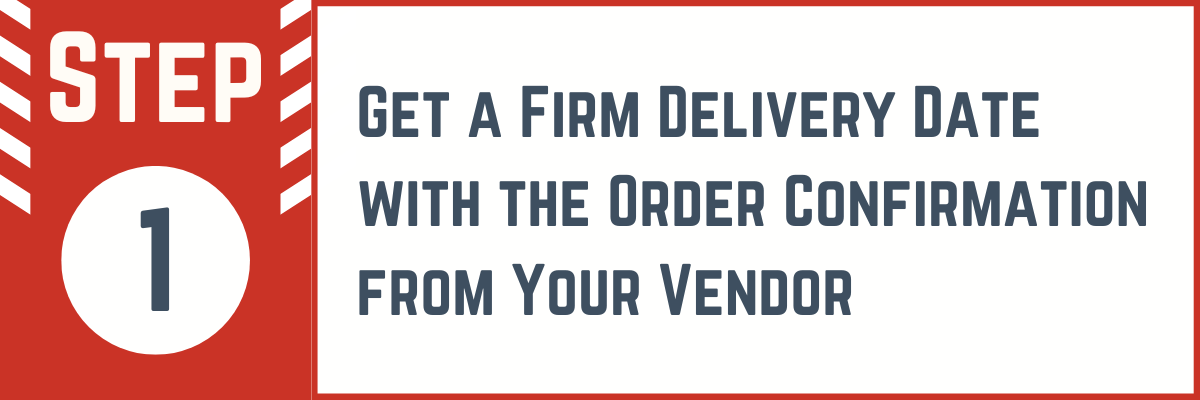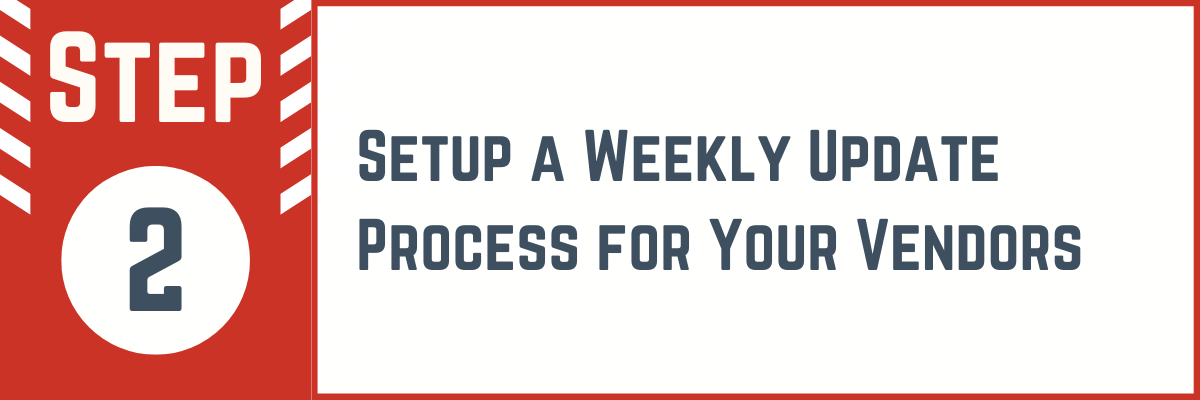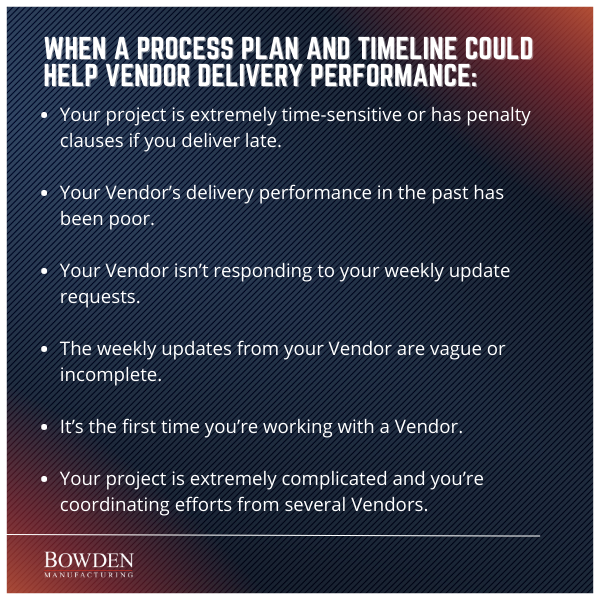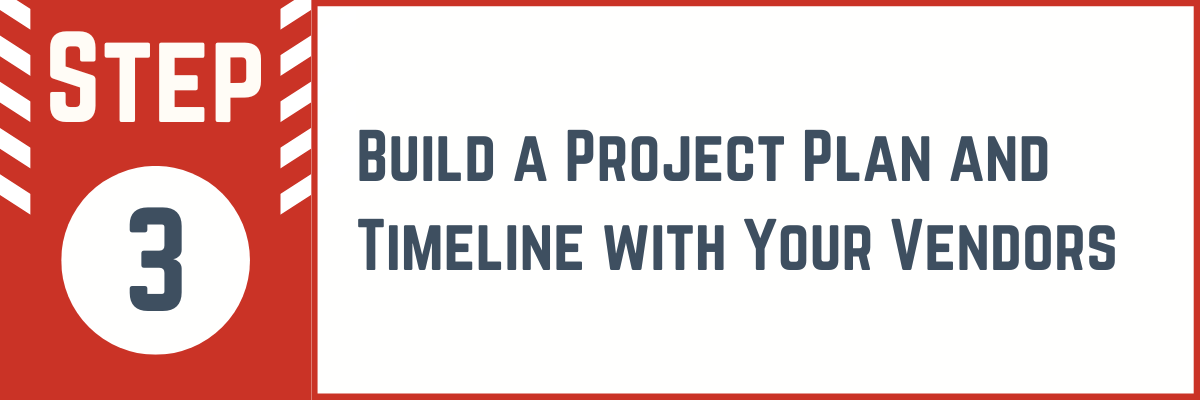We continue our Managing Your Supply Chain Series and our final topic is Managing Your Vendors for Delivery Performance.
The three big legs of the Supply Chain “stool” are typically price, quality, and delivery. Waiting for delivery is one of the most agonizing aspects of outsourcing. You expect the product will meet expectations, but you can’t do anything until it arrives. It can be a powerless feeling.
In our Managing Your Supply Chain Series, we’ve talked quite a bit about engagement between Customers and Vendors. We’ve suggested that if you engage with your Vendors in a positive way, you can reduce the feeling of powerlessness in the relationship. Since we are both a Vendor to some companies and a Customer to others, we deal with both sides of this delivery equation.
In this installment, we’re sharing 3 steps that can improve the delivery performance from your Vendors.
3 Steps to Getting Delivery Performance from Your Vendors
1. Start with The Lead Time in their Quote/Proposal and Get a Delivery Promise Date
Most Quotes and Proposals list an expected lead time for delivery. It’s usually an estimate based on the activity level at the Vendor when the quote or proposal is being written. The more time that elapses before an order is placed, the less accurate the lead time is likely to be. The order you place should take into account the estimated lead time, but you should always ask for confirmation of the order details with specific emphasis on the delivery date.
Due to the uncertainty of when orders will be placed, proposed lead times are guesses based on quite a bit of uncertainty. Typically, the lead time encompasses queue time that will vary based on how busy your Vendor is when the product is being produced. Asking your Vendor to provide a firm delivery date is the first step to getting delivery performance because you can expect that the timing may have changed from the time they provided the initial quote or proposal.

2. Regularly Ask for Updates & Review the Responses
Any relationship or partnership is built on communication, but it’s typical that Customers will place an order and never initiate any additional conversation with their Vendors until a delivery is received or the delivery date is missed. As a Customer, you can do better than that by setting up a consistent means of requesting updated status on the product. Providing a regular opportunity for your Vendor to confirm that the project is on track will ensure they are reminded of your project on a regular basis. A weekly update request is a solid rhythm that can be effective without being oppressive to your Vendor.
Reviewing the responses from your Vendor will either give you confidence that they have things well in hand or create concern for the accuracy of their delivery prediction. Even if they seem to have things well in hand, it doesn’t mean that everything will go as expected, but getting consistent, clear communication about their plans and processes should provide confidence that the outcome is likely to be as anticipated. On the other hand, if the responses are vague, it could mean that you need to increase the frequency of the requests or ask additional questions for more details.
Make it as easy as possible for your Vendors to provide their information and you’ll get improved responses to your update requests. The weekly communications help keep your Vendors thinking about your project and feeding you updated information along the path toward delivery.

3. Develop a Process Plan and Timeline with Your Vendor
There are several reasons why you might need to go beyond just requesting weekly updates from your Vendor:

Requesting a Process Plan and Timeline from your Vendor is an important opportunity to improve delivery performance. Identifying the steps that the Vendor will take to produce the product, along with their estimated time to completion will do at least two things for you:
- It will provide an outline for your weekly update requests to give you better understanding of your Vendor’s progress and how likely it will be that they are on track.
- It will ensure that both you and your Vendor understand what needs to happen for the successful completion of the project, giving you the opportunity to explore ways to help ensure your Vendor achieves the outcome.
You can simply request that your Vendor provide the Process Plan and Timeline, or you can schedule a meeting to work through it with them. Typically, the more dialog you can have with your Vendor about the project, the more details and potential roadblocks surface. Having clear communications up front will increase the likelihood of a successful outcome. Additionally, reviewing the Process Plan and Timeline to ensure adequate buffer time is built into the schedule will help your Vendor deal with unexpected challenges and hurdles without compromising the delivery date. Just the act of reviewing the project will often catch errors or steps that might otherwise have been overlooked.
One aspect of the project that will likely benefit from prior conversation between you and your Customer is the First Article approval. Because a First Article involves acceptance by your Team before your Vendor can produce the remaining products, it’s important to be on the same page as to how that will happen. Ensuring you have notice prior to receipt of a First Article can help shorten the timing of the approval. The sooner issues can be addressed and/or production can be commenced after the First Article review, the better it will be for all parties.
Getting the proper players in the room for good dialog on these aspects of the project is not easy but the value in having the conversations is extremely high. When appropriate, building a Project Plan and Timeline with your Vendor goes a long way to improving Vendor delivery performance.

Final Thoughts
Successfully managing your Supply Chain’s delivery performance is important for your success. Ensuring that you receive order confirmation from your Vendor and get a confirmed delivery date is a big first step. Requesting weekly status updates on your project is an additional step that can give you peace of mind that your Vendor has things under control. Sometimes it will make sense to take the additional step to work with your Vendor to develop a Process Plan and Timeline to ensure everything goes smoothly.
Next week, we’ll wrap up our Managing Your Supply Chain Series with a summary of all we’ve discussed. We’ll makes sure you’ve got the most important takeaways to keep your Supply Chain serving you well.
